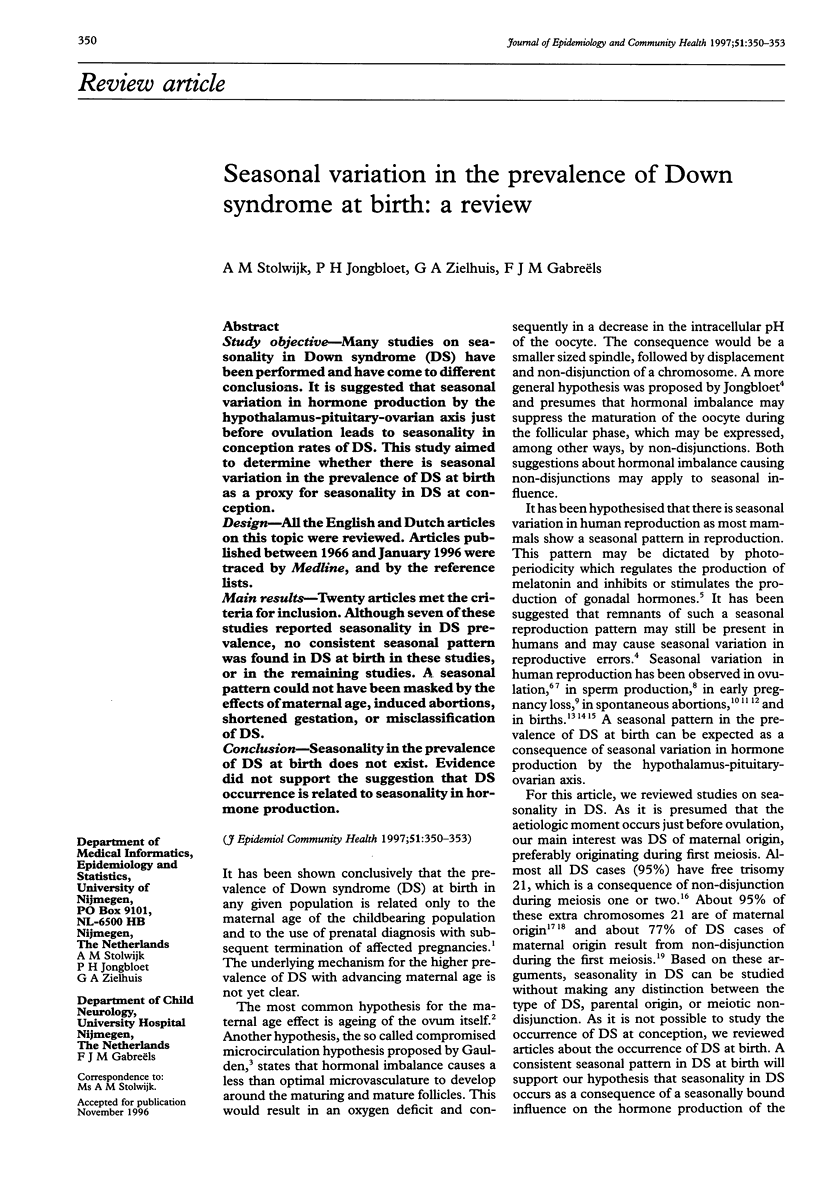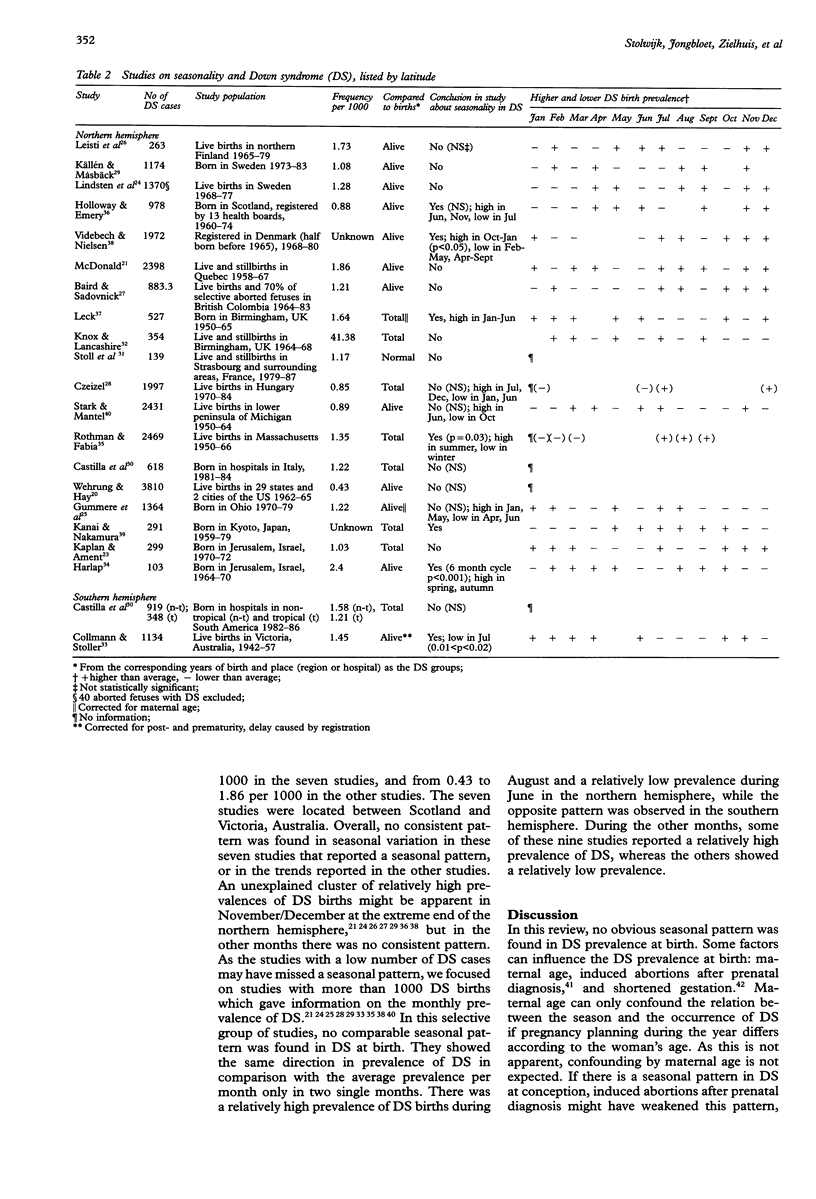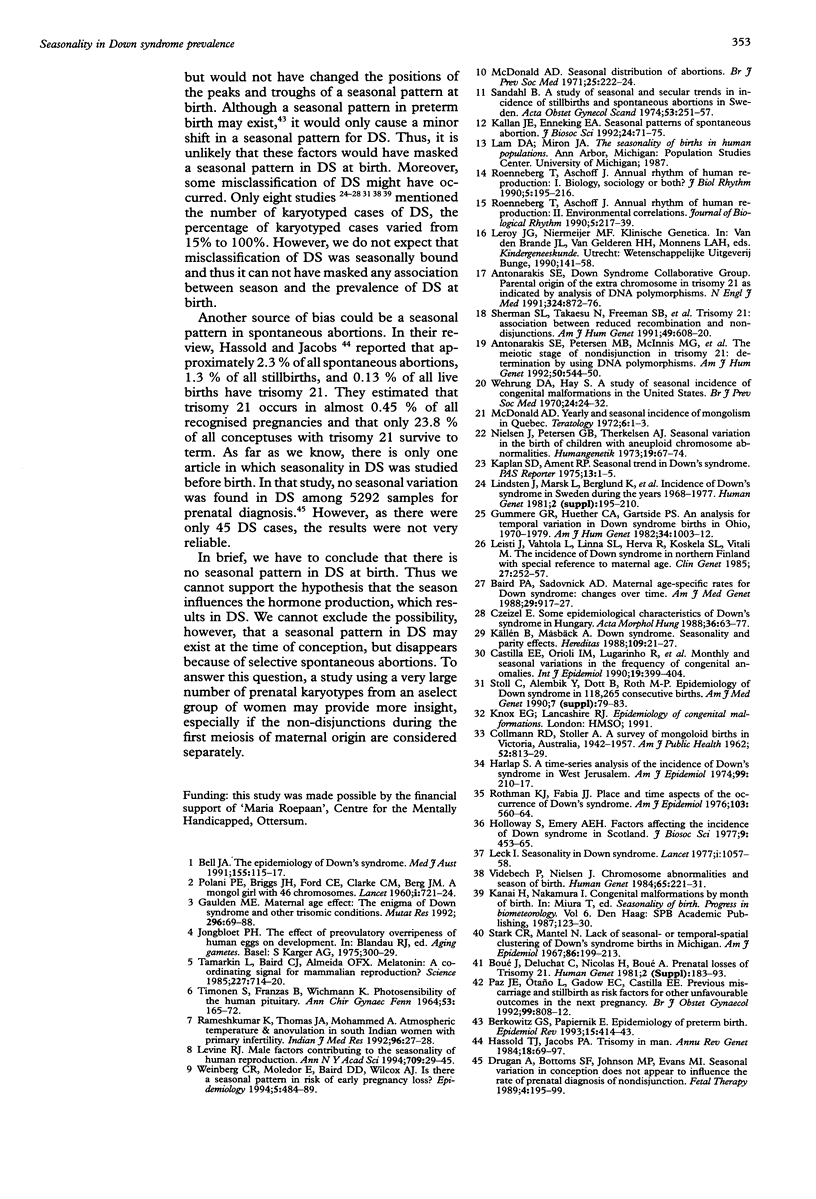Abstract
STUDY OBJECTIVE: Many studies on seasonality in Down syndrome (DS) have been performed and have come to different conclusions. It is suggested that seasonal variation in hormone production by the hypothalamus-pituitary-ovarian axis just before ovulation leads to seasonality in conception rates of DS. This study aimed to determine whether there is seasonal variation in the prevalence of DS at birth as a proxy for seasonality in DS at conception. DESIGN: All the English and Dutch articles on this topic were reviewed. Articles published between 1966 and January 1996 were traced by Medline, and by the reference lists. MAIN RESULTS: Twenty articles met the criteria for inclusion. Although seven of these studies reported seasonality in DS prevalence, no consistent seasonal pattern was found in DS at birth in these studies, or in the remaining studies. A seasonal pattern could not have been masked by the effects of maternal age, induced abortions, shortened gestation, or misclassification of DS. CONCLUSION: Seasonality in the prevalence of DS at birth does not exist. Evidence did not support the suggestion that DS occurrence is related to seasonality in hormone production.
Full text
PDF



Selected References
These references are in PubMed. This may not be the complete list of references from this article.
- Antonarakis S. E. Parental origin of the extra chromosome in trisomy 21 as indicated by analysis of DNA polymorphisms. Down Syndrome Collaborative Group. N Engl J Med. 1991 Mar 28;324(13):872–876. doi: 10.1056/NEJM199103283241302. [DOI] [PubMed] [Google Scholar]
- Antonarakis S. E., Petersen M. B., McInnis M. G., Adelsberger P. A., Schinzel A. A., Binkert F., Pangalos C., Raoul O., Slaugenhaupt S. A., Hafez M. The meiotic stage of nondisjunction in trisomy 21: determination by using DNA polymorphisms. Am J Hum Genet. 1992 Mar;50(3):544–550. [PMC free article] [PubMed] [Google Scholar]
- Baird P. A., Sadovnick A. D. Maternal age-specific rates for Down syndrome: changes over time. Am J Med Genet. 1988 Apr;29(4):917–927. doi: 10.1002/ajmg.1320290424. [DOI] [PubMed] [Google Scholar]
- Bell J. A. The epidemiology of Down's syndrome. Med J Aust. 1991 Jul 15;155(2):115–117. doi: 10.5694/j.1326-5377.1991.tb142143.x. [DOI] [PubMed] [Google Scholar]
- Berkowitz G. S., Papiernik E. Epidemiology of preterm birth. Epidemiol Rev. 1993;15(2):414–443. doi: 10.1093/oxfordjournals.epirev.a036128. [DOI] [PubMed] [Google Scholar]
- Boué J., Deluchat C., Nicolas H., Boué A. Prenatal losses of trisomy 21. Hum Genet Suppl. 1981;2:183–193. doi: 10.1007/978-3-642-68006-9_14. [DOI] [PubMed] [Google Scholar]
- COLLMANN R. D., STOLLER A. A survey of mongoloid births in Victoria, Australia, 1942-1957. Am J Public Health Nations Health. 1962 May;52:813–829. doi: 10.2105/ajph.52.5.813. [DOI] [PMC free article] [PubMed] [Google Scholar]
- Castilla E. E., Orioli I. M., Lugarinho R., Dutra G. P., Lopez-Camelo J. S., Campana H. E., Spagnolo A., Mastroiacovo P. Monthly and seasonal variations in the frequency of congenital anomalies. Int J Epidemiol. 1990 Jun;19(2):399–404. doi: 10.1093/ije/19.2.399. [DOI] [PubMed] [Google Scholar]
- Czeizel E. Some epidemiological characteristics of Down's syndrome in Hungary. Acta Morphol Hung. 1988;36(1-2):63–77. [PubMed] [Google Scholar]
- Drugan A., Bottoms S. F., Johnson M. P., Evans M. I. Seasonal variation in conception does not appear to influence the rate of prenatal diagnosis of nondisjunction. Fetal Ther. 1989;4(4):195–199. doi: 10.1159/000263451. [DOI] [PubMed] [Google Scholar]
- Gaulden M. E. Maternal age effect: the enigma of Down syndrome and other trisomic conditions. Mutat Res. 1992 Dec;296(1-2):69–88. doi: 10.1016/0165-1110(92)90033-6. [DOI] [PubMed] [Google Scholar]
- Gummere G. R., Huether C. A., Gartside P. S. An analysis for temporal variation in Down syndrome births in Ohio, 1970-1979. Am J Hum Genet. 1982 Nov;34(6):1003–1012. [PMC free article] [PubMed] [Google Scholar]
- Harlap S. A time-series analysis of the incidence of Down's syndrome in West Jerusalem. Am J Epidemiol. 1974 Mar;99(3):210–217. doi: 10.1093/oxfordjournals.aje.a121604. [DOI] [PubMed] [Google Scholar]
- Holloway S., Emery A. E. Factors affecting the incidence of Down syndrome in Scotland. J Biosoc Sci. 1977 Oct;9(4):453–465. doi: 10.1017/s0021932000011299. [DOI] [PubMed] [Google Scholar]
- Kallan J. E., Enneking E. A. Seasonal patterns of spontaneous abortion. J Biosoc Sci. 1992 Jan;24(1):71–75. doi: 10.1017/s0021932000006805. [DOI] [PubMed] [Google Scholar]
- Källén B., Måsbäck A. Down syndrome. Seasonality and parity effects. Hereditas. 1988;109(1):21–27. doi: 10.1111/j.1601-5223.1988.tb00177.x. [DOI] [PubMed] [Google Scholar]
- Leck I. Seasonality in Down syndrome. Lancet. 1977 May 14;1(8020):1057–1058. doi: 10.1016/s0140-6736(77)91295-8. [DOI] [PubMed] [Google Scholar]
- Leisti J., Vahtola L., Linna S. L., Herva R., Koskela S. L., Vitali M. The incidence of Down syndrome in northern Finland with special reference to maternal age. Clin Genet. 1985 Mar;27(3):252–257. doi: 10.1111/j.1399-0004.1985.tb00216.x. [DOI] [PubMed] [Google Scholar]
- Levine R. J. Male factors contributing to the seasonality of human reproduction. Ann N Y Acad Sci. 1994 Feb 18;709:29–45. doi: 10.1111/j.1749-6632.1994.tb30386.x. [DOI] [PubMed] [Google Scholar]
- Lindsten J., Marsk L., Berglund K., Iselius L., Ryman N., Annerén G., Kjessler B., Mitelman F., Nordenson I., Wahlström J. Incidence of Down's syndrome in Sweden during the years 1968-1977. Hum Genet Suppl. 1981;2:195–210. [PubMed] [Google Scholar]
- McDonald A. D. Seasonal distribution of abortions. Br J Prev Soc Med. 1971 Nov;25(4):222–224. doi: 10.1136/jech.25.4.222. [DOI] [PMC free article] [PubMed] [Google Scholar]
- McDonald A. D. Yearly and seasonal incidence of mongolism in Quebec. Teratology. 1972 Aug;6(1):1–3. doi: 10.1002/tera.1420060102. [DOI] [PubMed] [Google Scholar]
- Nielsen J., Petersen G. B., Therkelsen A. J. Seasonal variation in the birth of children with aneuploid chromosome abnormalities. Report from the Danish Cytogenetic Central Register. Humangenetik. 1973;19(1):67–74. doi: 10.1007/BF00295236. [DOI] [PubMed] [Google Scholar]
- POLANI P. E., BRIGGS J. H., FORD C. E., CLARKE C. M., BERG J. M. A Mongol girl with 46 chromosomes. Lancet. 1960 Apr 2;1(7127):721–724. doi: 10.1016/s0140-6736(60)90614-0. [DOI] [PubMed] [Google Scholar]
- Paz J. E., Otaño L., Gadow E. C., Castilla E. E. Previous miscarriage and stillbirth as risk factors for other unfavourable outcomes in the next pregnancy. Br J Obstet Gynaecol. 1992 Oct;99(10):808–812. doi: 10.1111/j.1471-0528.1992.tb14411.x. [DOI] [PubMed] [Google Scholar]
- Rameshkumar K., Thomas J. A., Mohammed A. Atmospheric temperature & anovulation in south Indian women with primary infertility. Indian J Med Res. 1992 Feb;96:27–28. [PubMed] [Google Scholar]
- Roenneberg T., Aschoff J. Annual rhythm of human reproduction: I. Biology, sociology, or both? J Biol Rhythms. 1990 Fall;5(3):195–216. doi: 10.1177/074873049000500303. [DOI] [PubMed] [Google Scholar]
- Roenneberg T., Aschoff J. Annual rhythm of human reproduction: II. Environmental correlations. J Biol Rhythms. 1990 Fall;5(3):217–239. doi: 10.1177/074873049000500304. [DOI] [PubMed] [Google Scholar]
- Rothman K. J., Fabia J. J. Place and time aspects of the occurrence of Down's syndrome. Am J Epidemiol. 1976 Jun;103(6):560–564. doi: 10.1093/oxfordjournals.aje.a112260. [DOI] [PubMed] [Google Scholar]
- Sandahl B. A study of seasonal and secular trends in incidence of stillbirths and spontaneous abortions in Sweden. Acta Obstet Gynecol Scand. 1974;53(3):251–257. doi: 10.3109/00016347409162166. [DOI] [PubMed] [Google Scholar]
- Sherman S. L., Takaesu N., Freeman S. B., Grantham M., Phillips C., Blackston R. D., Jacobs P. A., Cockwell A. E., Freeman V., Uchida I. Trisomy 21: association between reduced recombination and nondisjunction. Am J Hum Genet. 1991 Sep;49(3):608–620. [PMC free article] [PubMed] [Google Scholar]
- Stark C. R., Mantel N. Lack of seasonal- or temporal-spatial clustering of Down's syndrome births in Michigan. Am J Epidemiol. 1967 Jul;86(1):199–213. doi: 10.1093/oxfordjournals.aje.a120725. [DOI] [PubMed] [Google Scholar]
- Stoll C., Alembik Y., Dott B., Roth M. P. Epidemiology of Down syndrome in 118,265 consecutive births. Am J Med Genet Suppl. 1990;7:79–83. doi: 10.1002/ajmg.1320370715. [DOI] [PubMed] [Google Scholar]
- TIMONEN S., FRANZAS B., WICHMANN K. PHOTOSENSIBILITY OF THE HUMAN PITUITARY. Ann Chir Gynaecol Fenn. 1964;53:165–172. [PubMed] [Google Scholar]
- Tamarkin L., Baird C. J., Almeida O. F. Melatonin: a coordinating signal for mammalian reproduction? Science. 1985 Feb 15;227(4688):714–720. doi: 10.1126/science.3881822. [DOI] [PubMed] [Google Scholar]
- Videbech P., Nielsen J. Chromosome abnormalities and season of birth. Hum Genet. 1984;65(3):221–231. doi: 10.1007/BF00286507. [DOI] [PubMed] [Google Scholar]
- Wehrung D. A., Hay S. A study of seasonal incidence of congenital malformations in the United States. Br J Prev Soc Med. 1970 Feb;24(1):24–32. doi: 10.1136/jech.24.1.24. [DOI] [PMC free article] [PubMed] [Google Scholar]
- Weinberg C. R., Moledor E., Baird D. D., Wilcox A. J. Is there a seasonal pattern in risk of early pregnancy loss? Epidemiology. 1994 Sep;5(5):484–489. [PubMed] [Google Scholar]


